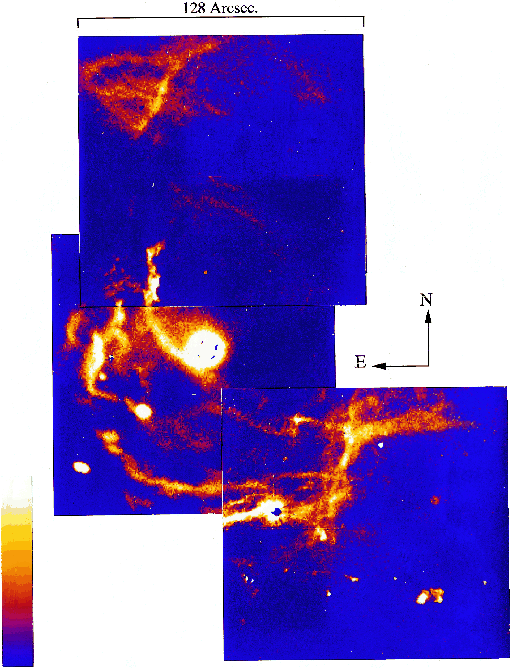
H2 filaments in NGC 2023
Credit: Image courtesy of D. Field1 & J.L. Lemaire2
1 Institute of Physics and Astronomy, University of Aarhus, Denmark
2 Observatoire de Paris-Meudon, Meudon, France

Stars are born in various sizes, from the smallest to the heaviest.
When a star is massive, it lives a bright, luminous, but short life.
In that case the internal temperature is large enough that huge
supplies of hydrogen are burned at once, very rapidly, and almost as
soon as the stars is born, it burns out, in a matter of a few millions
years only. By comparison to our Sun that is 5 Billion years old, in
its mid-life, these massive stars die at an early age. If our Sun
could be assimilated to a 40 year old human, in its mid-life, these
stars would die before they are 6 months old on the same scale!
During this brief life, these stars shine like no other. Their light
illuminates the gas and dust enveloppes surrounding them, creating
extended nebulae. The strong UV radiation emanating from these hot
stars strongly excite nearby gas molecules and atoms which in turn
reemit light at specific wavelengths, producing emission lines. In
particular, one of the main constituent of the interstellar medium,
the hydrogen molecule (H2), possesses a few strong lines in the
near-infrared domain. By shining strongly on them, massive stars
excite the hydrogen molecules in their environment and thereby allow a
detailed study of the material from which stars are born.
This week's image features NGC 2023, a reflection nebula surrounding a
massive B star located at a distance of 500 pc from the Sun. The image
shows pure emission from the H2 molecule, excited by the strong UV
field of the central B star (luminous knot at the center of the map,
best located in the corresponding
continuum image). The map reveals large filaments of molecular gas
which show structure down to a milliparsec scale, the smallest scales
observable. The brightness of the emission detected also allows to
estimate the density of the particles forming the filaments. The
densities derived of 10^5 particles per cubic centimeter are 5 orders
of magnitude larger than the average density between stars in our
Galaxy. Stars form in a very dense and highly structured medium !
NGC 2023 was observed with the
REDEYE. near infrared camera attached to the f/8 CVassegrain focus
of the Canada-France-Hawaii Telescope. the observations were
performed on December 1st & 2nd, 1993.
Two filters were used to produce the image presented this week. One
centered on a strong molecular hydrogen line at 2.121 microns (H2
S(1)(1-0) and an adjacent continuum filter centered at 2.179
microns. The continuum image has
been subtracted to the line image to produce the map of pure H2
emission presented here. The resolution of the images, limited by the
seeing, is about 0.8 arcsec and the field of view is 128x128 arcsec.
Technical description:



